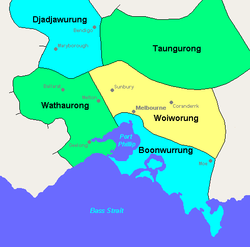Wurundjeri
According to the early Australian ethnographer Alfred William Howitt, the name Wurundjeri, in his transcription Urunjeri, refers to a species of eucalypt, Eucalyptus viminalis, otherwise known as the manna or white gum, which is common along the Yarra River.
These took in the areas of the Yarra and Saltwater rivers around Melbourne, and ran north as far as Mount Disappointment, northwest to Macedon, Woodend, and Lancefield.
[2] As colonization began, it was estimated that something of the order of 11,500-15,000 Aborigines, composed of some 38 tribal groups, were living in the area of Victoria.
[10][11] The earliest European settlers came across a park-like landscape extending inland from Melbourne, consisting of large areas of grassy plains to the north and southwest, with little forest cover, something thought to be testimony of indigenous sheet burning practices to expose the massive number of yam daisies which proliferated in the area.
The Wurundjeri and Gunung Willam Balug clans mined diorite at Mount William stone axe quarry which was a source of the highly valued greenstone hatchet heads, which were traded across a wide area as far as New South Wales and Adelaide.
The mine provided a complex network of trading for economic and social exchange among the different Aboriginal nations in Victoria.
John Batman and other whites interpreted this symbolic act, recorded in treaty form, as equivalent to medieval enfeoffment of all Woiwurrong territory.
They were armed with rifles, and esteemed to be excellent marksmen, firing close to Anderson to drive him off as they helped themselves to his potato crop while en route to Yering in 1840.
[17][18]In 1863 the surviving members of the Wurundjeri tribe were given "permissive occupancy" of Coranderrk Station, near Healesville and forcibly resettled.
Despite numerous petitions, letters, and delegations to the Colonial and Federal Government, the grant of this land in compensation for the country lost was refused.
All remaining Wurundjeri people are descendants of Bebejan, through his daughter Annie Borate (Boorat), and in turn, her son Robert Wandin (Wandoon).


